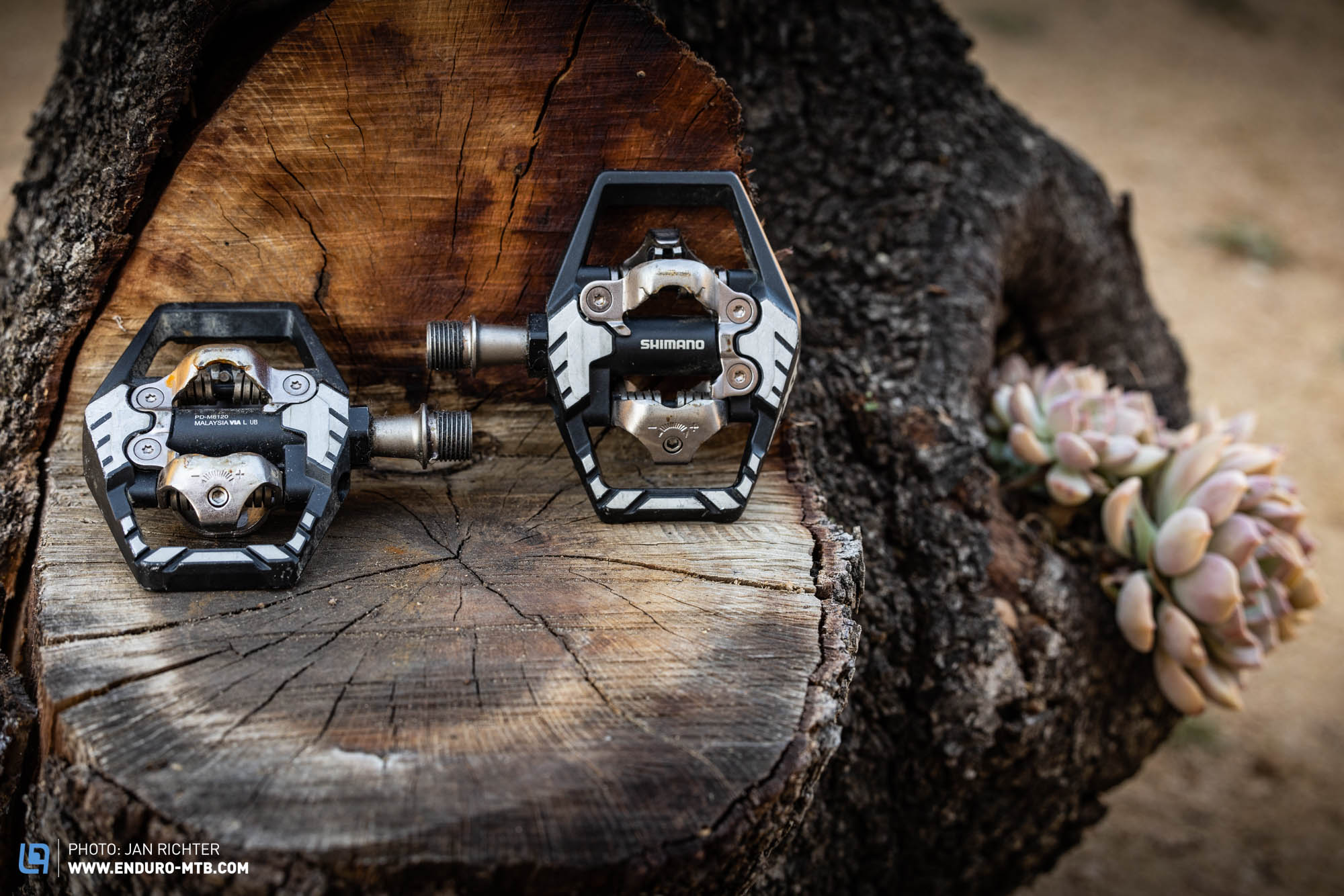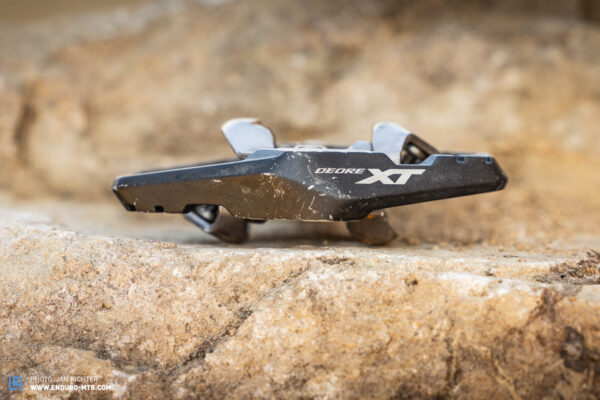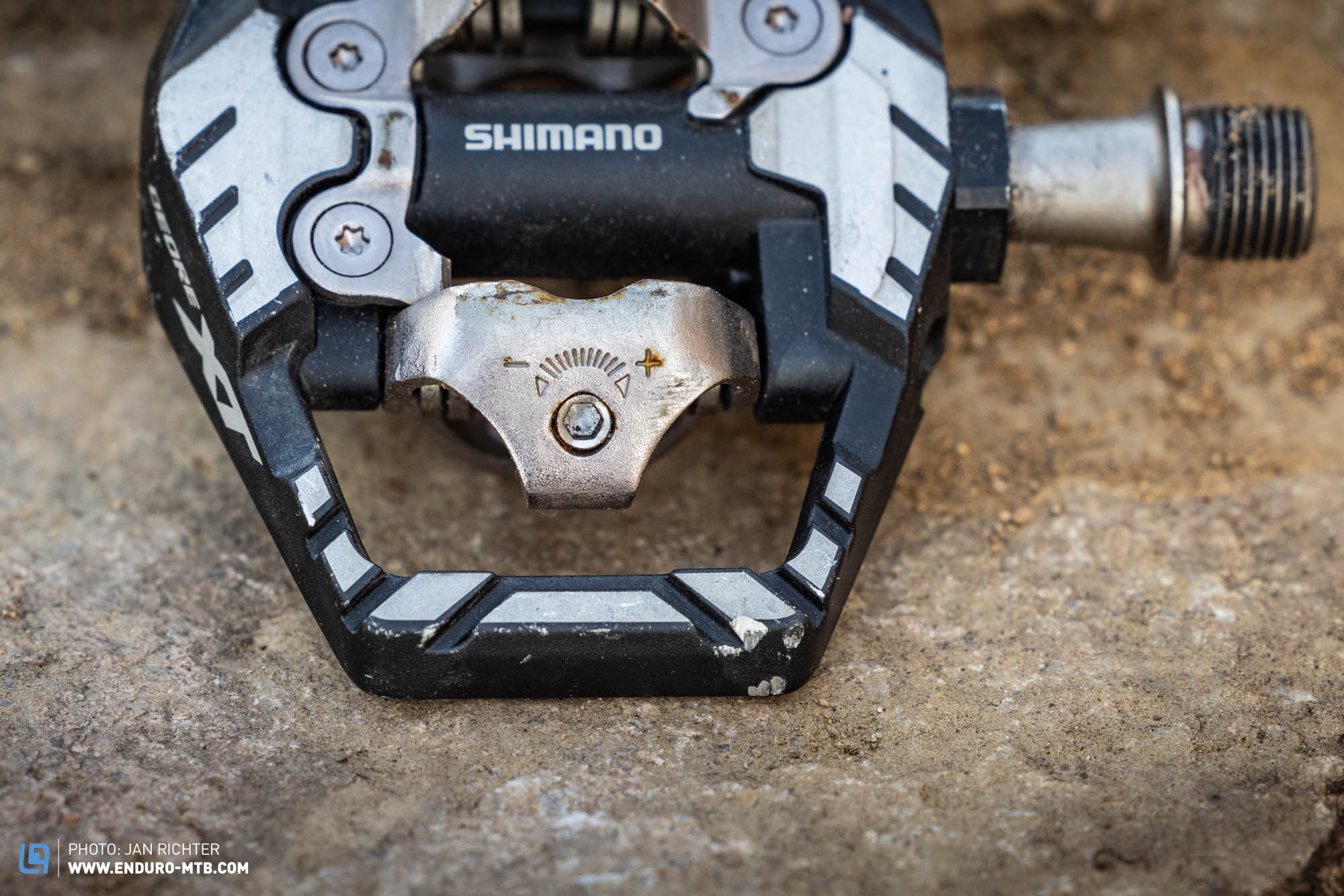Shimano pedals and the SPD system are almost synonymous with clipless mountain bike pedals. The SPD mechanism is so widespread that many other manufacturers use it on their pedals. But is the original always the best? We pitted the Shimano DEORE XTs against five other pedals.

Release angle 13° | Q-factor55 mm |Manufacturer’s website
The full name of the pedals is Shimano DEORE XT PD-M8120. The numerical gibberish helps to differentiate them from the cross-country variants without cages. But to keep things simple for the purposes of this review, we’re just going to call them the XT pedals here. The Shimano XTs are the only pedals on test that don’t have any pins in their aluminium cages, but the spring preload of the clipless mechanism can be adjusted. The front part of the bracket is fixed, and the rear part is spring-loaded. The float and release angles sit at 4° and 13° with the supplied cleats. Priced at € 134.95, they’re the second most affordable pedals in the test field, and the pair weighs 426 g.


The Shimano DEORE XT PD-M8120 pedals on the trail
The action of clicking into the SPD pedals is similar to that of ski binding: you must hook the cleat under the bracket at the front and then push your heel down. It might sound complicated at first, but it’s quick and intuitive to do. They provide a good level of feedback, and you can clearly hear and feel when you’re clicked in. At 4°, they don’t offer much float and you can clearly feel when you reach the limit as you hit the spring-loaded bracket. It feels more on/off than free. The adjustment of the spring preload makes a clearly noticeable difference, ranging from being able to click in and out with hardly any effort to wondering if you’ll ever be able to put your feet down. The aluminium cages are robust, and the XTs are very durable, showing no visible signs of wear on the pedals or cleats even after several months of intensive use. Should any break, you won’t have any problems getting spare parts, because the Shimano system is widespread like no other. Without pins, the cages offer hardly any grip, so you’ll slip rather easily if you’re not clicked in, and when you are, the soles of your shoes don’t touch the cages. Thus, the cages are there more to protect the SPD mechanism than to provide additional support for your feet. Another drawback is the poor self-cleaning: in muddy conditions, dirt is likely to accumulate under the front bracket and thus make it a lot harder to click in.

The Shimano DEORE XT PD-M8120 pedals have established themselves as the standard among clipless pedals for a reason. The spring preload offers a large adjustment range, and the mechanism feels defined, though the float feels somewhat on/off. However, their self-cleaning is poor and the small cages don’t provide much grip or support. Their durability, on the other hand, is among the best and, together with the availability of spare parts, that makes the XTs a superb low-maintenance option.
Tops
- excellent durability
- widely adjustable spring preload
- defined clicked in feeling
- spare parts are widely available
Flops
- on/off feeling of the float
- poor self-cleaning
- small cages don’t offer support
You can find out more about at bike.shimano.com
Click here for an overview: The best pedals for mountain bikers
all pedals in Review: Acros Clipless Pedal | Crankbrothers Mallet E LS | Hope Union | HT T2 | Shimano XT PD-M8120 | TIME SPECIALE 12 | Chromag Dagga | Crankbrothers Stamp 7 | Hope F22 | Look Trail Fusion | Nukeproof Horizon Pro Sam Hill | OneUp Composite Pedal | Race Face Atlas | Sixpack Kamikaze RA | SQ Lab 50X | Tatze Link Composite |
Did you enjoy this article? If so, we would be stoked if you decide to support us with a monthly contribution. By becoming a supporter of ENDURO, you will help secure a sustainable future for high-quality mountain bike journalism. Click here to learn more.
Words: Simon Kohler Photos: Jan Richter









